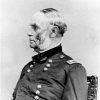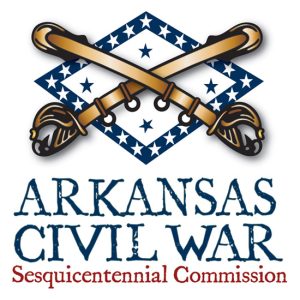calsfoundation@cals.org
Action at Sugar Creek
aka: Battle of Dunagin's Farm
aka: Action at Little Sugar Creek
| Other Names: | Battle of Dunagin’s Farm, Action at Little Sugar Creek |
| Location: | Benton County |
| Campaign: | Pea Ridge Campaign |
| Date: | February 17, 1862 |
| Principal Commanders: | Major General Samuel R. Curtis (US); Brigadier General Benjamin McCulloch (CS) |
| Forces Engaged: | Army of the Southwest (US); Army of Arkansas (CS) |
| Estimated Casualties: | 13 killed and an estimated 20 wounded (US); Confederate casualties are undocumented, but Federals claimed that 26 Confederate dead were left on the field |
| Result: | Inconclusive |
The Action at Sugar Creek, commonly known as the Battle of Dunagin’s Farm, was the first battle of the Civil War wholly fought in Arkansas and was part of the tug of war between the North and the South for control of Missouri.
In late 1861, after the victory at Wilson’s Creek on August 10, 1861, the Missouri State Guard under Major General Sterling Price occupied Springfield, Missouri, and settled into winter quarters, not expecting pressure from Federal troops until spring. But on January 1, 1862, Major General Samuel R. Curtis and the Union’s Army of the Southwest prepared to march on Springfield and rid Missouri of enemy troops. Price, aware of the Federals’ advance, knew that he could not hold southern Missouri without the help of Arkansas Confederate forces led by Brigadier General Benjamin McCulloch. As the Federals came closer to Springfield, Price began to wire McCulloch, sending a stream of frantic dispatches for help to northwest Arkansas. Deep in the Boston Mountains, 8,700 Confederate soldiers under McCulloch were in winter quarters, and McCulloch, who was in Richmond, Virginia, meeting with Confederate president Jefferson Davis, had left James McIntosh in command of the Arkansas army in his absence. Because an army’s engagement in winter was unlikely, McIntosh only advised Colonel Louis Hébert to be ready to march toward Springfield just in case. Price, who was not satisfied with the lack of movement from Arkansas, dispatched even more calls for assistance to McIntosh, Hébert, and even Earl Van Dorn, stationed in eastern Arkansas. However, since it took so long for the dispatches to be delivered due to distance, geography, and weather, Van Dorn was not even aware that the Federals were on the move until they had already taken Springfield on February 13.
Once Curtis entered Springfield and realized the Confederates had evacuated south, he was determined to follow them. The night before the chase began, a fierce winter storm hit the Ozark Mountains, and while most of the Federal soldiers were comfortable in newly acquired Springfield, the Confederates were forced to brave the elements. The following morning, the Federals set out in pursuit of the Confederates. For four days, they marched along Telegraph Road, one of the few good roads in the Ozarks. The poorly equipped Confederates had the Federals lashing at them as they fled, and sharp engagements flared between the Confederate rear guard and the Union troops beginning about thirty miles south of Springfield. Price, attempting to protect the rear of his army, used the rear guard to keep the larger Union troops at bay until the Confederates could get to McCulloch’s reinforcements, which he hoped were on the way to meet him. Once the two armies began making contact, they continued to do so all the way to Arkansas. The weather turned intensely cold, and the soldiers and animals in both armies endured snow, sleet, and freezing rain. Hundreds of exhausted Rebels were found along the roadside. Curtis reported to Halleck that “more straggling prisoners are being taken than I know what to do with.”
Early on the morning of February 16, a message from Price informed Hébert of the fall of Springfield and of the Federal pursuit. Astounded, Hébert immediately informed McCulloch, and they prepared to march to Price’s relief. On the afternoon of February 16, a portion of Hébert’s Confederate command made contact with the Missouri army about three miles south of the Arkansas-Missouri line near Elkhorn Tavern. Hébert’s men stepped aside to let the long, exhausted column shuffle past and then took up the position of rear guard.
Early morning on February 17, Curtis’s Federal army crossed the state line into Arkansas and continued to push southward. Colonel Calvin Ellis’s Federal cavalry passed through Cross Timber Hollow around 1:00 pm and noisily trudged past Elkhorn Tavern, reaching the bluffs overlooking Little Sugar Creek after the Missouri State Guard had marched out only hours earlier. Hébert’s men—the Third Louisiana and the Fourth and Fifteenth Arkansas—were waiting for them as they were covering Price’s continued withdrawal. Little’s infantry and Clark’s battery, part of Sterling Price’s command that had been protecting Price’s rear on the retreat from Springfield, were left with Hébert to assist in any forthcoming Federal assault. Confident that the Federal army would not assault such a fortified position, Hébert quietly withdrew his troops and proceeded to follow Price. Curtis’s Federal army followed, however.
Since Hébert was not able to return to his imposing position on the bluffs, he had no choice but to stand and fight where he was. He placed his regiments on the eastern side of Telegraph Road—Little’s infantry on the western side, and Clark’s battery in the center, all facing north. The Confederate troops were placed along the southern edge of a large field belonging to a farmer named James (or Jasper, as the 1870 census has it) Dunagin, and the First Missouri Cavalry were dismounted and dispatched to the woods as skirmishers 400 yards in front of the infantry and artillery. When Ellis and the Federals reached the top of the southern bluffs, he spotted Confederate stragglers hurrying away to the south, and he followed at a gallop without waiting for infantry or artillery support. After advancing about half a mile, the Federals ran into the Confederate position on Dunagin’s farm. Clark’s battery opened the engagement with a salvo straight down Telegraph Road. Ellis immediately ordered the Federal First Missouri Cavalry off the road to the left and right. Taking their cue from Ellis, Wright swung his battalion of the Sixth Missouri Cavalry into the woods to the right of the road, while McConnell led his battalion of the Third Illinois Cavalry to the left.
Telegraph Road was soon empty except for the leading battalion of the First Missouri Cavalry, led by Major James M. Hubbard, which advanced at a dead run directly toward the Rebel position. At this moment, Rebel cavalry swarmed out of the woods, and the mass of horsemen swept into Dunagin’s field. The battle continued as Ellis realized that this was more than his command could handle, and he ordered a withdrawal. Curtis rushed reinforcements to the battle and ascended the southern bluffs in Ellis’s rear. The Third Iowa battery took position in the center of the road opposite the Confederate batteries, and they proceeded to exchange fire. Although the Federal infantry, the Ninth Iowa, were closest to the Federal battery, they came through unscathed because they lay on the ground. The Confederate infantry on either side of Clark’s battery was not so fortunate; several projectiles cut down men standing in the Rebel ranks. About 4:00 p.m., Hébert disengaged. Curtis chose not to follow.
For additional information:
Shea, William, and Earl Hess. Pea Ridge: Civil War Campaign in the West. Chapel Hill: University of North Carolina Press, 1992.
Shea, William L. The Campaign for Pea Ridge. National Park Civil War Series. Washington DC: Eastern National, 2001.
The War of the Rebellion: A Compendium of the Official Records of the Union and Confederate Armies. Series I, Vol. 8. Washington DC: Government Printing Office, 1883.
Christene Ashlock
Harrison, Arkansas
 Civil War through Reconstruction, 1861 through 1874
Civil War through Reconstruction, 1861 through 1874 Military
Military Pea Ridge, Battle of
Pea Ridge, Battle of Pott's Hill, Action at
Pott's Hill, Action at ACWSC Logo
ACWSC Logo  Samuel Curtis
Samuel Curtis 



Very cool, Grant! Glad you enjoyed it and you were able to use it.
Just played this scenario in the Battle Cry game! Thanks for the additional information on the skirmish.